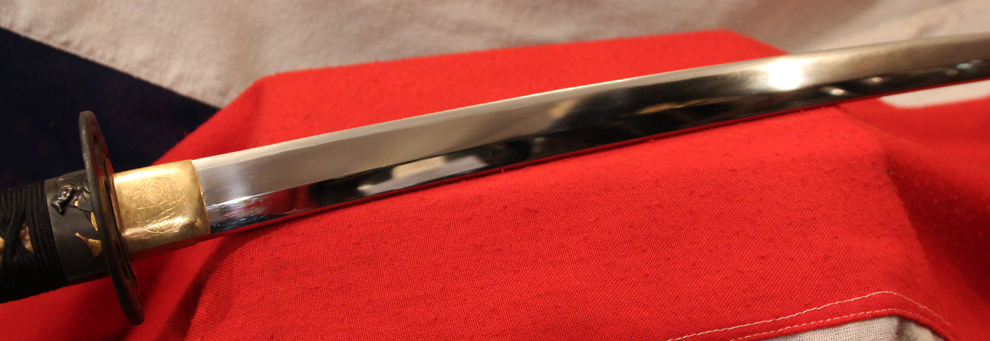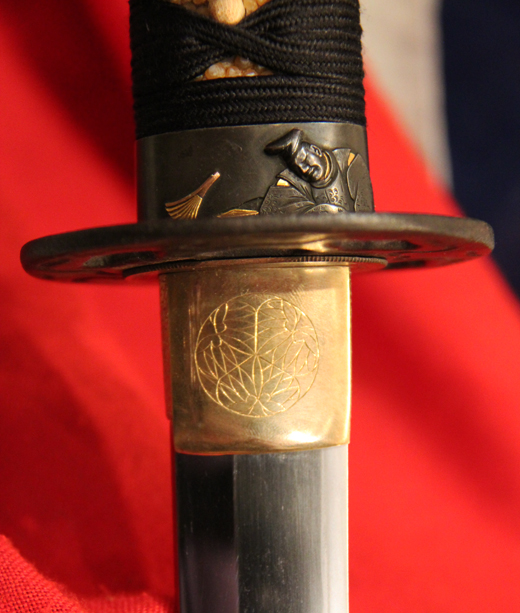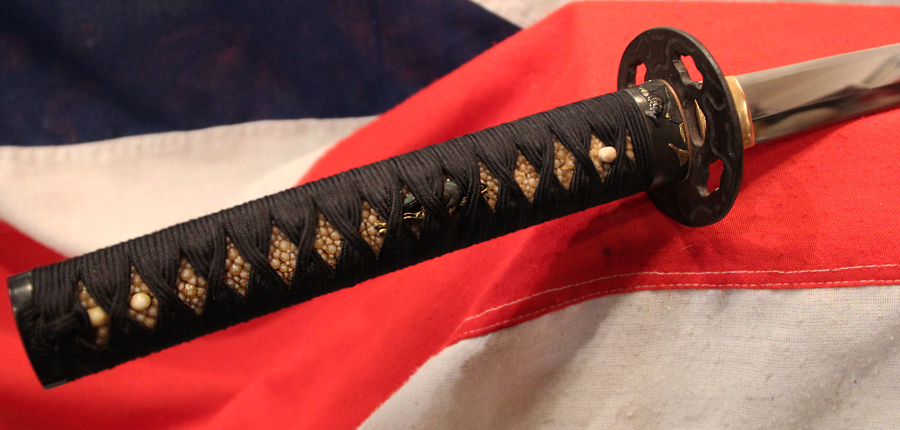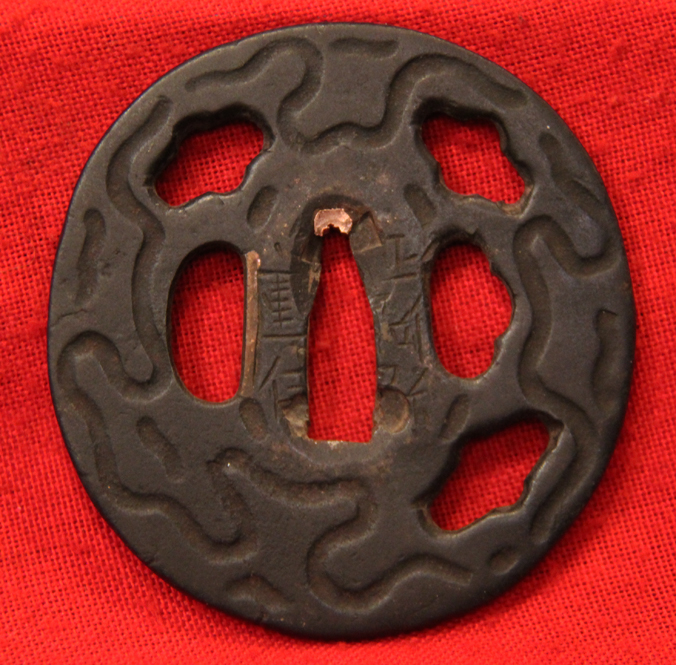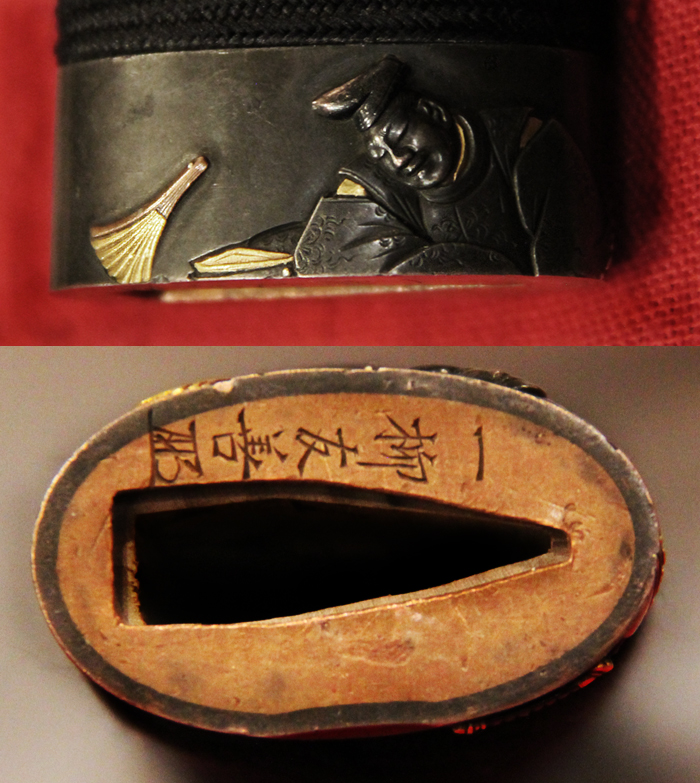A Simply Beautiful Ancient Koto Katana, Sengoku Era, Circa 1530, Signed Fuchi with Artisans Kakihan of a Cursive Monogram and Signed Tsuba, And the Matsudaira Tokugawa Clan Mon Gold Habaki
Beautiful Koto blade with wonderful quality original Edo fittings of a signed fushi hilt mount of shakudo and pure gold, with a takebori samurai daimyo lord, in court dress, wearing his tachi.
Very good tsuba in iron, also signed. Menuki of cranes underneath the silk ito. Very beautiful blade with typical Koto period narrow straight hamon of fine simplicity. Engraved gilt habaki blade collar with Tokugawa clan mon of Aoi hollyhock leaves. Original utushi lacquer saya with small wear areas. Bound with dark red and white sageo.
Before the Edo period, there were 19 major branches of the Matsudaira clan: Takenoya (竹谷), Katanohara (形原),4 Ōgusa (大草), Nagasawa (長沢),5 Nōmi (能見),6 Goi (五井), Fukōzu (深溝), Ogyū (大給),7 Takiwaki (滝脇),8 Fukama (福釜), Sakurai (桜井), Tōjō (東条), Fujii (藤井),9 Mitsugi (三木), Iwatsu (岩津), Nishi-Fukama (西福釜), Yata (矢田), Udono (鵜殿), and Kaga (加賀). Each of these branches (with the exception of the Kaga-Matsudaira, which relocated to Kaga Province) took its name from the area in Mikawa where it resided. Also, many of the branches often fought with each other.
Matsudaira of Okazaki
It was the main Matsudaira line residing in Okazaki Castle which rose the highest during the Sengoku period. During the headship of Matsudaira Hirotada, it was threatened by the Oda and Imagawa clans, and for a time was forcibly brought into Imagawa service. After the death of Imagawa Yoshimoto and the fall from power of the Imagawa clan, Hirotada's son Matsudaira Motoyasu was successful in forming an alliance with Oda Nobunaga, the hegemon of Owari Province. Motoyasu is better known as Tokugawa Ieyasu, who became the first Tokugawa shōgun in 1603.
The Sengoku Period (Sengoku Jidai, 1467-1568 CE), also known as the Warring States Period, was a turbulent and violent period of Japanese history when rival warlords or daimyo fought bitterly for control of Japan. The period falls within the Muromachi period (Muromachi Jidai, 1333-1573 CE) of Japanese medieval history when the Ashikaga shogun capital was located in the Muromachi area of Heiankyo (Kyoto). The beginning of the Sengoku period witnessed the Onin War (1467-1477 CE) which destroyed Heiankyo. The fighting that followed over the next century would eventually reduce the warlords to only a few hundred in number as the country was effectively carved up into princedoms. Eventually, one warlord rose above all his rivals: Oda Nobunaga, who set Japan on the road to unification from 1568 CE.
To many of us in the West, the movie image of the samurai in his fantastic armour, galloping into battle on his horse, his colourful personal flag, or sashimono, whipping in the wind on his back, has become the very symbol of Japan, the Empire of the Rising Sun. And, truly, to the samurai of real life, nothing embodied his warrior's code of Bushido more than his sword, considered inseparable from his soul.
Indeed, a sword was considered such a crucial part of a samurai's life that when a young samurai was about to be born, a sword was brought into the bedchamber during the delivery. When the time came for an old samurai to die and cross over into the White Jade Pavilion of the Afterlife his honoured sword was placed by his side. Even after death, a daimyo, or nobleman, believed he could count on his samurai who had followed him into the next world to use their keen blades to guard him against any demons, just as they had wielded their trusty weapons to defend him against flesh-and-blood enemies in this life. Shakudo is a billon of gold and copper (typically 4-10% gold, 96-90% copper) which can be treated to form an indigo/black patina resembling lacquer. Unpatinated shakudo Visually resembles bronze; the dark colour is induced by applying and heating rokusho, a special patination formula.
Shakudo Was historically used in Japan to construct or decorate katana fittings such as tsuba, menuki, and kozuka; as well as other small ornaments. When it was introduced to the West in the mid-19th century, it was thought to be previously unknown outside Asia, but recent studies have suggested close similarities to certain decorative alloys used in ancient Egypt, Greece, and Rome
Code: 22207
5750.00 GBP


